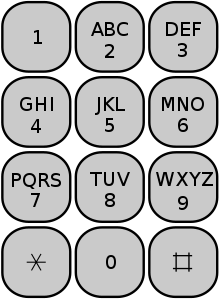E.161

E.161 is an ITU-T recommendation that defines the assignment of the basic 26 Latin letters (A to Z) to the 12-key telephone keypad. Uses for this mapping include:
- Multi-tap and predictive text systems
- Forming phonewords from telephone numbers
- Using alphabetic characters (e.g. as a mnemonic) in a personal identification number[1]
ETSI ETS 300 640 and ISO 9995-8 also address this. Language-specific letters (e.g. ü, é, å, ä, ö) as well as other characters (e.g. ‘€’ or ‘@’) are not addressed, which has led to a variety of inconsistent solutions for European languages.[2]
The E.161 layout is primarily based on the layout used on American telephones since the 1930s for telephone exchange names. Until the 1990s, Q and Z were not included in the standard layout, and since the letters served mainly as mnemonic devices, they were not necessary (Q and Z were not used in phonewords); telephones either omitted them, placed Q and Z onto the 1 key, or included Q and Z on the current locations, with PRS on 7 and with WXY on 9, respectively. The development of text messaging on mobile phones, which required the full range of the alphabet, led to the need to standardize locations for Q and Z on mobile devices. E.161 adopted the current layout in response to this.
See also
References
- ↑ ISO 9564-1:2011 Financial services — Personal Identification Number (PIN) management and security — Part 1: Basic principles and requirements for PINs in card-based systems, Annex B.4 Alpha-to-numeric mapping
- ↑ Böcker, Martin; Larsson, Karl Ivar; von Niman, Bruno, Standardization Supporting Cultural Diversity: Character Repertoires, Ordering and Assignment to the 12-key Telephone Keypad for European Languages and Languages Used in Europe (PDF), retrieved 2010-12-31